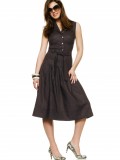Read this ebook for free! No credit card needed, absolutely nothing to pay.
Words: 25062 in 7 pages
This is an ebook sharing website. You can read the uploaded ebooks for free here. No credit cards needed, nothing to pay. If you want to own a digital copy of the ebook, or want to read offline with your favorite ebook-reader, then you can choose to buy and download the ebook.


: Birds and Nature Vol. 12 No. 2 [July 1902] Illustrated by Color Photography by Various Higley William Kerr Editor - Birds Periodicals; Natural history Periodicals
SEPTEMBER.
Graceful tossing plume of gold, Waving lowly on the rocky ledge; Leaning seaward, lovely to behold, Clinging to the high cliff's ragged edge;
Burning in the pure September day, Spike of gold against the stainless blue, Do you watch the vessels drifting by? Does the quiet day seem long to you? --Celia Thaxter, in "Seaside Goldenrod."
THE PALM WARBLER.
Then tiny warblers flit and sing, With golden spots on crest and wing, Or, decked with scarlet epaulette Above each dusky winglet set, They hunt the blossoms for their prey And pipe their fairy roundelay. --Rose Terry Cooke, "My Apple Tree."
There are two varieties of this species, the Palm or Red-poll Warbler, and the yellow palm or yellow red-poll warbler. The latter is a native of the Atlantic States and breeds from Maine northward to Hudson Bay. The former frequents the interior of the United States and migrates northward as far as the Great Slave Lake. It is seldom seen in the Atlantic States except during its migrations.
In this connection the account of Mr. William Dutcher, regarding the first observation of the Palm Warbler in Long Island, is of interest. It is the more interesting because it partially answers the question so often asked, "Where do the birds die?" Mr. Dutcher says, "During the night of the twenty-third of September, 1887, a great bird wave was rolling southward along the Atlantic coast. Mr. E. J. Udall, of the Fire Island Light, wrote me that the air was full of birds. Very many of the little travellers met with an untimely fate, for Mr. Udall picked up at the foot of the light house tower, and shipped to me, no less than five hundred and ninety-five victims. Twenty-five species were included in the number, all of them being land birds, very nearly half of which were Wood Warblers. Among them I found one Palm Warbler."
Both varieties winter in the Southern States that border the Atlantic ocean and the Gulf of Mexico, in Mexico and in the islands of the West Indies. While both birds are often seen in the same flock during the winter, the Palm Warbler is much more common in Florida than is the eastern cousin. When together the two forms may be readily distinguished by the brighter yellow of the yellow palm warbler.
Three of the large family of Wood Warblers may be called the vagabonds of the family, for they do not love the forest. These are the Palm, the yellow Palm and the Prairie Warblers.
Dr. Ridgway says of the Palm Warbler, "During the spring migration this is one of the most abundant of the warblers," in Illinois, "and for a brief season may be seen along the fences, or the borders of fields, usually near the ground, walking in a graceful, gliding manner, the body tilting and the tail oscillating at each step. For this reason it is sometimes, and not inappropriately called Wag-Tail Warbler." The observer is reminded of the titlarks as he watches the nervous activity of this Warbler as it constantly jerks its tail while it flutters about the hedges and scattered shrubbery, or when running on the ground among the weeds of old fields. It may even frequent dusty roadsides. Wherever it is, it frequently utters its low "tsip," a note that is very similar to that of many of its sister warblers.
Dr. Brewer says, "They have no other song than a few simple and feeble notes, so thin and weak that they might almost be mistaken for the sound made by the common grasshopper."
The Palm Warbler's nest is a trim structure, usually placed upon the ground and never far above it. The walls consist of interwoven dry grasses, stems of the smaller herbaceous plants, bark fibres and various mosses. It is lined with very fine grasses, vegetable down and feathers. Though this home is placed in quite open places, a retired spot is usually selected. Here are laid the white or buffy white eggs, more or less distinctly marked with a brownish color, and a family of four or five of these peculiar Warblers is raised.
Free books android app tbrJar TBR JAR Read Free books online gutenberg
More posts by @FreeBooks


: The Brochure Series of Architectural Illustration vol. 06 No. 04 April 1900 The Petit Trianon: Versailles; English Carved Fireplaces by Various - Architecture Periodicals






